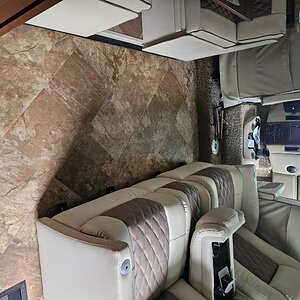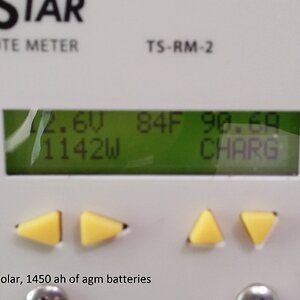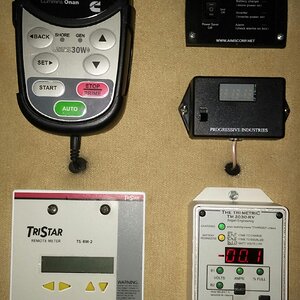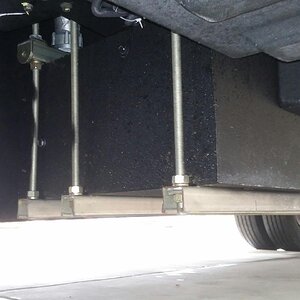Here’s a more in-depth piece I wrote and posted a while back. Its long story, probably needs some updating, and of course there’s more, but this basically sums up what I’ve learned over the last three years since I began this unwanted hobby:
This is a long post but it’s a long story, starting in 2010 when they prematurely implemented the DEF systems on diesel motor vehicles. This is 50+ year old proven technology, that works fine in stationary facilities such as factories and power plants, but it was simply not ready for the mobile environment when it was forced on the driving public. So…..
A lot of confusion comes from changes in emissions systems over the years (2007, 2010, 2016 etc) and yes, different chassis manufacturers. Spartan uses Shaw Development DEF heads as does (did?) Tiffin on the PowerGlide chassis. But both Newmar and Tiffin also offer many coach models on Freightliner chassis. FL‘s supplier (TE Connectivity for mine) seems to have solved the problem with their DEF “Headers” (FL‘s term - everyone else says DEF head) while those using Shaw lagged a couple years behind causing all kinds of chaos and troubles. They claim they’ve finally got it right with Gen 7 or 8 - we’ll see. Either way, the system architecture is basically the same as detailed in this article:
https://www.apta.com/wp-content/uploads/APTA_Presentation-Diesel-Aftertreatment-Systems.pdf
Among the most common problems are old DEF which is out of spec for the quality sensor (2016 and later) and high temperature which causes both a higher concentration of ammonia (damaging to all systems) and precipitation of salts which cause the float to hang up on pre-2016 systems as noted in the following TSB: (
https://static.nhtsa.gov/odi/tsbs/2013/MC-10142383-9999.pdf). High temps occur environmentally which is why there is a scale for DEF shelf life from over a year at around 60°F to 90 days at over 100°, but also can be due to a stuck tank heater valve. These valves fail in the open position heating your DEF to engine temp levels which of course destroys the DEF and subsequently the header. Smart design, hmmm? An easy fix here is to install a valve in the tank heater input line and shut it off and only open it if you are going to be driving in sub-freezing temps. They say DEF starts turning to slush at about 12* so that gives most of us a lot leeway.
A year or so ago, the EPA finally responded to the DEF header calamity, but with a weak, and more or less useless solution to the problem allowing engine to manufacturers to upload a software patch to work around a failed sensor problem because of an extreme shortage (using Covid as the Great Excuse) of parts. (See the EPA link at the bottom). But this did nothing for the stranded motorist and the restrictions placed on getting the “patch” uploaded are just as extreme as the problem. So far I’ve read of NO ONE who has found this solution satisfactory or benefitted from it in any way, but I suppose its possible. And of course the real problem is dependance on off-shore manufacturing, not Covid. And it”s important to understand that the vast majority of coaches stranded due to emissions system derating are a result of sensor failures (in the DEF head) while the emission system is actually functioning perfectly.
Another solution mentioned above is the DEF sensor simulator (
DEF Sensor Simulator). This is a much more effective work around and puts control in the vehicle owners hands, but will only work on 2016 and later emissions systems (one of them CAN bus deals) and requires some skills that are slightly above the basic level to build. The link noted provides good comprehensive instructions for acquiring parts, building, programming, installing and testing it, but it isn’t just plug and play. However it does work and is an excellent item for coaches with 2016 and later emissions systems and my recommendation is to build one and keep it with your spares in case you need it, and not waiting until you need it to pursue this solution.
For pre-2016 system owners, the TSB link above is IMPORTANT and even if you can’t do this fix yourself, a shop can IF they are aware if it. This is also why they say “keep your DEF tank full” but why its only applicable to pre-2016 systems. One thing you can try if you are getting the dreaded false “Low DEF” codes and facing de-rating, is to flush the tank a couple times with water (preferably distilled or very clean filtered) and then refill with new DEF. This has worked for some and avoided actual mechanical work on the vehicle. Also the image in the TSB shows the electrical connection to the header which you’ll note is why the DSS will not help with this type of system (older analog vs newer digital parts).
My coach is a 2016 but the chassis was built in 2015 and made it under the wire before the 2016 emissions came in to effect - another source of confusion. Pre-2106 systems have only level and temp sensors, and the sensor unit - DEF head(er), is actually serviceable in many instances of failure (again, see the TSB link). Post 2016 has level, temp, and quality sensors, they are solid state, and the electronics in the sensor head are much more susceptible to failure for a variety of reasons. These post-2016 sensors are also done once they fail, there is no mechanical fix other than replacement, and failures were so high initially that a significant shortage occurred leading to waiting lists, stranded motorists, and rigs stuck at shops waiting for parts for months!
Meanwhile one of the most significant problems is misinformation/lack of education for the owner/operator. Dealers don’t want to talk about it, the EPA took forever to even come up with a lame attempt to help that really doesn’t, and shops love the easy money and job security. So consumers are left to figure this out on their own. I have read many accounts of people spending $2-3k or more for work that is actually covered by the emissions warranty. I’ve sent a handful back for a refund and all have collected some or all of their money, but imagine the countless others who were taken on this. My theory is that shops do this for two reasons: 1) it’s easier to swipe a customer’s card than file paperwork and wait for payment from the manufacturer, and 2) they can charge the consumer A LOT more for the same work than the manufacturers will pay. Yes, laziness and greed. Go figure. Meanwhile dealers pretend the problem doesn't exist because they want to sell coaches, and of course a lot of them just don’t understand the vehicles they are selling.
Another issue to be aware of is the DEF filter. This is an inexpensive and easily performed maintenance item, but the manufacturers publish maintenance intervals anywhere from 200k-350k miles so most RV owners don’t change the filter, and shops naturally won’t change it unless asked to do so. This may work out fine for the trucking market because they put a lot of miles on their rigs quickly. RV owners will rarely get even close to 100k on rigs with DEF systems during 5 to 10 years of ownership. So we have these rigs that sit a lot, the filters dry out (and they are only paper elements), DEF crud precipitates out, and plugs them up, reducing flow and putting strain on the pump. I had a DEF pump failure at around 25k (causing another derate) probably because my rig sat a lot in Arizona over its first four years before I bought it with 16k on it.
So the moral or this story is to learn your vehicle, understand the emissions system for your model and year, know your warranty, and don’t take an unsatisfactory answer at face value. Get a code reader, preferably one with some basic emissions commands, and verify everything before handing over big bucks for repairs.
The article below gives a good explanation of DEF and also reminded me of another debate: pump (bulk) versus packaged DEF. Since the coach DEF systems have proven to be fragile, I only use packaged DEF with a decipherable date code for my coach, and this is my recommendation for anyone with a diesel RV, regardless of the manufacturer. My 2017 Ford F250 seems to be much more robust so it can use pump DEF. I also don’t depend on it as my domicile many miles from home.

en.wikipedia.org
A parting comment, then I’ll stop editing and updating all this: none of the DEF components or issues have anything to do with your DFP and regens (passive, active, or parked/forced) as DEF is introduced to the SCR AFTER the DPF. I’ve both experienced and read of instances where a shop tech will reccomend and/or perform a forced regen when faced with DEF head(er) codes, and then charge for it. Regens wont help with DEF issues, and DEF issues wont cause DPF problems so it’s important to separate the two when dealing with emissions related fault codes. This is a good reference to familiarize yourself with the emission systems:
https://www.apta.com/wp-content/uploads/APTA_Presentation-Diesel-Aftertreatment-Systems.pdf
And here’s a little happy horse manure from the folks that brought us this problem:
Diesel Exhaust Fluid (DEF) Updates

www.epa.gov














